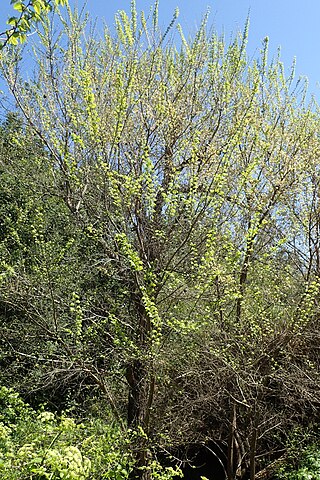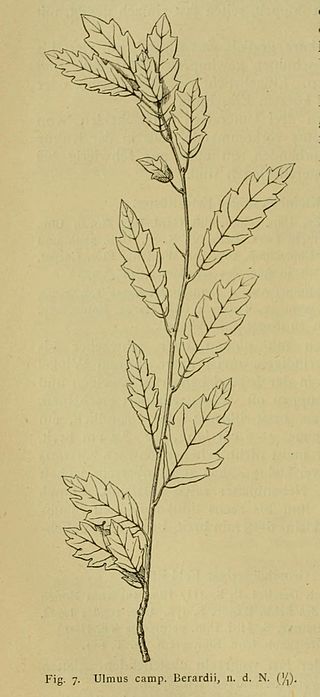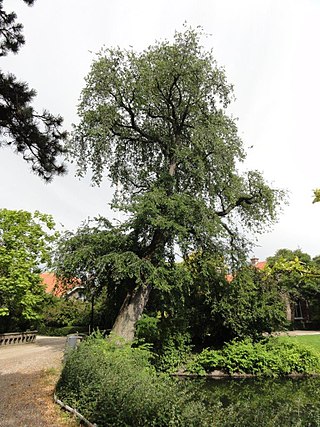Related Research Articles

The hybrid elm cultivar Ulmus × hollandica 'Smithii', commonly known as the Downton Elm, was one of a number of cultivars arising from the crossing of the Wych Elm U. glabra with the Field Elm U. minor. The tree was originally planted at Downton Castle near Ludlow, as one of a batch, not all of them pendulous in habit, raised at Smith's Nursery, Worcester, England, from seeds obtained from a tree in Nottingham in 1810.
The hybrid elm cultivar Ulmus × hollandica 'Dauvessei', one of a number of cultivars arising from the crossing of the Wych Elm U. glabra with a variety of Field Elm U. minor, is a very rare cultivar said to have originated at the D. Dauvesse nursery in Orléans, France before 1877.

Ulmus minorsubsp.canescens is a small deciduous tree occasionally known by the common names grey elm, grey-leafed elm, and hoary elm. Its natural range extends through the lands of the central and eastern Mediterranean, from southern Italy, the islands of Sicily, Malta, Crete, Rhodes and Cyprus, to Turkey, and as far south as Israel, where it is now considered rare and endangered in the wild. The tree is typically found amidst the comparatively humid coastal woodlands and scrublands.

The Field Elm cultivar Ulmus minor 'Umbraculifera' [:shade-giving] was originally cultivated in Iran, where it was widely planted as an ornamental and occasionally grew to a great size, being known there as 'Nalband' Persian: نعلبند [:the tree of the farriers]. Litvinov considered it a cultivar of a wild elm with a dense crown that he called U. densa, from the mountains of Turkestan, Ferghana, and Aksu. Non-rounded forms of 'Umbraculifera' are also found in Isfahan Province, Iran. Zielińksi in Flora Iranica considered it an U. minor cultivar.

The elm cultivar Ulmus 'Berardii', Berard's Elm, was raised in 1865, as Ulmus Berardi, from seeds collected from large specimens of "common elm" growing on the ramparts at Metz, by an employee of the Simon-Louis nursery named Bérard. Carrière (1887), the Späth nursery of Berlin and the Van Houtte nursery of Gentbrugge regarded it as form of a Field Elm, listing it as U. campestris Berardii, the name used by Henry. Cheal's nursery of Crawley distributed it as Ulmus nitens [:Ulmus minor] 'Berardii'. Smith's of Worcester preferred the original, non-specific name, Ulmus 'Berardii'.
The Field Elm cultivar Ulmus minor 'Cucullata', the Hooded elm, was listed by Loddiges of Hackney, London, in their catalogue of 1823 as Ulmus campestris cucullata, and later by Loudon in Arboretum et Fruticetum Britannicum (1838), as U. campestris var. cucullata.
The elm cultivar Ulmus 'Tortuosa'Host, the Wiggly Elm, was described by Host in Flora Austriaca (1827) as Ulmus tortuosa, from low, twisted, small-leaved trees that grew in the hilly districts of Hungary. A contemporary herbarium specimen (1833) from Central Europe labelled U. tortuosaHost appears to show small field elm-type leaves. Henry distinguished 'Tortuosa' Host from Loddiges' and Loudon's U. tortuosa, which he identified with Ulmus 'Modiolina', "l'orme tortillard" of France. Henry noted, however, that abnormal sinuous or zigzagging growth "might occur in any kind of elm", and herbarium specimens of elms labelled 'Tortuosa' range from U. minor cultivars to hybrid cultivars, some treated as synonymous with 'Modiolina'. A large-leaved U. campestris tortuosa was described by David in Revue horticole (1846), while a hybrid var. tortuosa cultivar from Louveigné, Belgium, with twisted trunk and large leaves, was described by Aigret in 1905. An U. campestris suberosa tortuosa was marketed in the 1930s by the Hesse Nursery of Weener, Germany, by its description a contorted form of corky-barked field elm.
The cultivar Ulmus 'Virens', the Kidbrook Elm, is an elm of unknown origin. It was first identified by Masters as U. virens in Hortus Duroverni 67, 1831, and later by Loudon in Arboretum et Fruticetum Britannicum, 3: 1376, 1838, as U. campestris virens. Described in some detail by Elwes & Henry (1913) as a form of Field Elm but classified as U. × hollandica by Green, the tree is not mentioned in Bean's classic works on British trees.
The hybrid cultivar Ulmus × hollandica 'Etrusca' was first mentioned by Nicholson in Kew Hand-List Trees & Shrubs 2: 139. 1896, as U. montana var. etrusca, but without description. The tree at Kew, judged by Henry to be "not distinct enough to deserve a special name", was later identified as of hybrid origin, U. glabra × U. minor 'Plotii', by Melville.
The elm cultivar Ulmus 'Myrtifolia', the Myrtle-leaved Elm, first appeared in nursery and horticultural lists from the 1830s, as Ulmus myrtifolia and Ulmus campestris myrtifolia, the name Ulmus myrtifoliaVolxem being used at Kew Gardens from 1880. Lawson's nursery of Edinburgh appears to have been the earliest to list the tree. 'Myrtifolia' was listed by Nicholson in Kew Hand-List Trees & Shrubs (1896), but without description. It was later listed as a cultivar and described by Rehder in 1939 and by Krüssmann in 1962.

The Field Elm cultivar Ulmus minor 'Umbraculifera Gracilis' was obtained as a sport of 'Umbraculifera' by the Späth nursery of Berlin c.1897. It was marketed by the Späth nursery in the early 20th century, and by the Hesse Nursery of Weener, Germany, in the 1930s.

The Field Elm cultivar Ulmus minor 'Pendula' was said to have been raised in Belgium in 1863. It was listed as Ulmus sativa pendula by C. de Vos in 1887, and by Boom in 1959 as a cultivar.

The Field Elm cultivar Ulmus minor 'Suberosa', commonly known as the Cork-barked elm, is a slow-growing or dwarf form of conspicuously suberose Field Elm. Of disputed status, it is considered a distinct variety by some botanists, among them Henry (1913), Krüssmann (1984), and Bean (1988), and is sometimes cloned and planted as a cultivar. Henry said the tree "appears to be a common variety in the forests of central Europe", Bean noting that it "occurs in dry habitats". By the proposed rule that known or suspected clones of U. minor, once cultivated and named, should be treated as cultivars, the tree would be designated U. minor 'Suberosa'. The Späth nursery of Berlin distributed an U. campestris suberosa alataKirchn. [:'corky-winged'] from the 1890s to the 1930s.
The Field Elm cultivar Ulmus minor 'Viminalis Betulaefolia' (:'birch-leaved') is an elm tree of uncertain origin. An U. betulaefolia was listed by Loddiges of Hackney, London, in the catalogue of 1836, an U. campestris var. betulaefolia by Loudon in Arboretum et Fruticetum Britannicum (1838), and an U. betulifoliaBooth by the Lawson nursery of Edinburgh. Henry described an U. campestris var. betulaefolia at Kew in 1913, obtained from Fulham nurseryman Osborne in 1879, as "scarcely different from var. viminalis ". Melville considered the tree so named at Kew a form of his U. × viminalis, while Bean (1988), describing U. 'Betulaefolia', likewise placed it under U. 'Viminalis' as an apparently allied tree. Loudon and Browne had noted that some forms of 'Viminalis' can be mistaken for a variety of birch. An U. campestris betulaefolia was distributed by Hesse's Nurseries, Weener, Germany, in the 1930s.
The Field Elm cultivar Ulmus minor 'Viminalis Stricta' (:'narrow'), formerly known as U. campestris var. viminalis stricta, is a fastigiate form of Ulmus minor 'Viminalis'. A herbarium specimen at Kew labelled U. campestris var. viminalis f. stricta was considered by Melville a form of his U. × viminalis.

The field elm cultivar Ulmus minor 'Viminalis' (:'willow-like'), occasionally referred to as the twiggy field elm, was raised by Masters in 1817, and listed in 1831 as U. campestris viminalis, without description. Loudon added a general description in 1838, and the Cambridge University Herbarium acquired a leaf specimen of the tree in 1866. Moss, writing in 1912, said that the Ulmus campestris viminalis from Cambridge University Herbarium was the only elm he thought agreed with the original Plot's elm as illustrated by Dr. Plot in 1677 from specimens growing in an avenue and coppice at Hanwell near Banbury. Elwes and Henry (1913) also considered Loudon's Ulmus campestris viminalis to be Dr Plot's elm. Its 19th-century name, U. campestris var. viminalis, led the cultivar to be classified for a time as a variety of English Elm. On the Continent, 'Viminalis' was the Ulmus antarcticaHort., 'zierliche Ulme' [:'dainty elm'] of Kirchner's Arboretum Muscaviense (1864).
The elm cultivar Ulmus 'Turkestanica' was first described by Regel as U. turkestanica in Dieck, Hauptcat. Baumschul. Zöschen (1883) and in Gartenflora (1884). Regel himself stressed that "U. turkestanica was only a preliminary name given by me; I regard this as a form of U. suberosa" [:U. minor ]. Litvinov considered U. turkestanicaRegel a variety of his U. densa, adding that its fruits were "like those of U. foliaceaGilibert" [:U. minor].

The Wych Elm cultivar Ulmus glabra 'Concavaefolia', a form with up-curling leaves, was listed in Beissner's Handbuch der Laubholz-Benennung (1903) as Ulmus montana cucullataHort. [:'hooded', the leaf], a synonym of the Ulmus scabraMill. [:glabraHuds.] var. concavaefolia of herbarium specimens. An Ulmus campestris cucullata, of uncertain species, had appeared in Loddiges' 1823 list, but Loudon's brief description (1838) of concave- and hooded-leaved elms was insufficient for later botanists to distinguish them. The earliest unambiguous description appears to be that of Petzold and Kirchner in Arboretum Muscaviense (1864).

The wych elm cultivar Ulmus glabraHuds. 'Superba', Blandford Elm, with unusually large leaves, was raised by Gill's of Blandford Forum, Dorset, in the early 1840s as Ulmus montana superba and was quickly distributed to other UK nurseries. It was confirmed as a form of wych, and first described by Lindley in The Gardeners' Chronicle, 1845, later descriptions being added by Gill (1845) and Morren (1848), who called it U. montana var. superba. Morren had adopted the name 'Superba' from the Fulham nurseryman Osborne in 1844, who supplied him with the tree – presumably one of the nurseries supplied by Gill. Morren states that 'Superba', already in cultivation in England, was introduced to Belgium by Denis Henrard of Saint Walburge, Liège, that in 1848 it had been present in Belgium for only three years, and that this variety was the one described as 'Superba' by Osborne, whom Henrard had visited at his nursery in Fulham in September 1844. 'Blandford Elm', with leaves of the same dimensions, was soon for sale in the USA.
The Field Elm cultivar Ulmus minor 'Glandulosa' was described as Ulmus glabra [:smooth-leaved] Mill. var. glandulosa by Lindley in A Synopsis of British Flora, arranged according to the Natural Order (1829), from trees near Ludlow, Shropshire. Melville identified a specimen in Ludlow in 1939, calling it in a 1946 paper "a good form of U. carpinifolia" [:U. minor ], describing it more fully and renaming it U. carpinifoliaGled. var. glandulosa (Lindl.). Regarding it as out of its natural range and deliberately planted, he referred to it as The Ludlow Elm, the "type tree" of a "variety" of Field Elm. Herbarium specimens of 'Glandulosa' are held in both the Lindley Herbarium in Cambridge and the Borrer Herbarium at Kew.
References
- ↑ Nicholson, George (1896). Hand-list of trees and shrubs. Vol. 2. p. 135.
- ↑ Green, Peter Shaw (1964). "Registration of cultivar names in Ulmus". Arnoldia. Arnold Arboretum, Harvard University. 24 (6–8): 41–80. Retrieved 16 February 2017.
- 1 2 Ulmus campestris var. cretensis herbarium specimen, Kew Gardens, herbariaunited.org specimen 289491 (1908; A. Ley)
- 1 2 'Canescens' in Crete, in the Apokoronas region: George Sfikas, Trees and shrubs of Greece (Athens, 2nd ed. 2001) p.140
- 1 2 'Canescens' in Crete, in the Aghia Irene gorge in the Temenos region: Natural Europe Project, University of Crete, europeana.eu
- ↑ "Field elm by Church of St. Nicholas, Kyriakosellia (Kiriakosellia), Crete". Google Maps. September 2011. Retrieved 2018-10-23.
- ↑ "Specimen - P06883116". Collection: Vascular plants (P). Muséum national d’Histoire naturelle, Paris (France). Sheet labelled U. campestris (long-shoot specimen from Apokoronas, Crete, 1915)